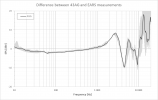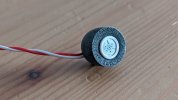Basically title but with some more detail: I'm looking for the best closed back in terms of detail/speed/etc. Essentially, everything besides FR (well perhaps low and high extension might count here as I found that you can't eq the lowest lows and the highest highs if the headphones are too rolled off). Ideally these cans will also be somewhat portable (not super light necessarily but at least better than 600g Audeze at least) and money is almost no object (but if a 500$ or 1000$ pair can actually compete with the top dogs then that's great).
I understand most people say FR is sort of the be all/ end all of how a headphone sounds so if you just eq everything to harman (or close enough) it should sound the same. But this has simply not been true in my experience, with some clear differences in sound between different headphones. These differences are most stark between driver types, but admittedly I don't own any high end dynamics (I have LCD2 Closed Classic, Verum One, Gold Planar GL2000, some dyi headphones with supposedly beryllium drivers from aliexpress + a bunch of IEMs). Where I found these differences the largest was when I got my first Stax a few months ago (some old lambda pro classic) and with/ without eq they just sound absolutely unbelievable compared to any of my other headphones (fyi whoever said stax don't have bass hasn't heard a good lambda eq'd to the harman target, the bass on these is far away better than anything I've heard in any planar or dynamic). What I mean by better is kind of hard to quantify precisely, perhaps I just mean distortion, as it's sort of the opposite of loose, crappy bass you would get from something like a cheap headphone (think skullcandy/beats). Maybe this is more apparent in the bass because of the level of bass I prefer (a few db north of harman) which will actually start to distort in all headphones (but not on estats). Interesting side note, I think the elevated bass is preferable for me because I'm quite sensitive to highs (I can also still hear up to 19.5k so that might play into it vs a lot of older ears who prefer a more "neutral" signature). But that also means that extension at the highest end (beyond 14k) actually makes a difference for me and I suspect this is also part of the stax magic (this extensions most likely affects the harmonics for mids/highs but I have no idea of the precise mechanism).
Anyway, this was a bit of a rant, but I'm looking to replicate as much of this sonical performance (of the eq'd stax) in a closed back, somewhat portable set of headphones. If they can be driven directly from something like a qudelix 5k, that would be even better but I'm open to trickier setups as I'm not actually going to use these running or anything that active. Think more moving them around and using them with people around potentially, but would also be nice on walks/public transport if possible.
Some current contenders I was looking at:
- DCA Aeon X closed/2 Noir, Stealth;
- Focal Celestee, Stellia;
- ZMF Verite Closed;
- Final Audio Sonorous x/viii/vi
I would say out of those the Stellia seem like a good mix of everything but maybe beat by the Stealth in outright technical ability (by how much, especially both being eq'd and specifically for the lowest sub-bass and 14k+ extension is the question for anyone who has tried both).
Would be great to hear what people think, especially if you've had a similar goal and have tried various closed back with that in mind.
I understand most people say FR is sort of the be all/ end all of how a headphone sounds so if you just eq everything to harman (or close enough) it should sound the same. But this has simply not been true in my experience, with some clear differences in sound between different headphones. These differences are most stark between driver types, but admittedly I don't own any high end dynamics (I have LCD2 Closed Classic, Verum One, Gold Planar GL2000, some dyi headphones with supposedly beryllium drivers from aliexpress + a bunch of IEMs). Where I found these differences the largest was when I got my first Stax a few months ago (some old lambda pro classic) and with/ without eq they just sound absolutely unbelievable compared to any of my other headphones (fyi whoever said stax don't have bass hasn't heard a good lambda eq'd to the harman target, the bass on these is far away better than anything I've heard in any planar or dynamic). What I mean by better is kind of hard to quantify precisely, perhaps I just mean distortion, as it's sort of the opposite of loose, crappy bass you would get from something like a cheap headphone (think skullcandy/beats). Maybe this is more apparent in the bass because of the level of bass I prefer (a few db north of harman) which will actually start to distort in all headphones (but not on estats). Interesting side note, I think the elevated bass is preferable for me because I'm quite sensitive to highs (I can also still hear up to 19.5k so that might play into it vs a lot of older ears who prefer a more "neutral" signature). But that also means that extension at the highest end (beyond 14k) actually makes a difference for me and I suspect this is also part of the stax magic (this extensions most likely affects the harmonics for mids/highs but I have no idea of the precise mechanism).
Anyway, this was a bit of a rant, but I'm looking to replicate as much of this sonical performance (of the eq'd stax) in a closed back, somewhat portable set of headphones. If they can be driven directly from something like a qudelix 5k, that would be even better but I'm open to trickier setups as I'm not actually going to use these running or anything that active. Think more moving them around and using them with people around potentially, but would also be nice on walks/public transport if possible.
Some current contenders I was looking at:
- DCA Aeon X closed/2 Noir, Stealth;
- Focal Celestee, Stellia;
- ZMF Verite Closed;
- Final Audio Sonorous x/viii/vi
I would say out of those the Stellia seem like a good mix of everything but maybe beat by the Stealth in outright technical ability (by how much, especially both being eq'd and specifically for the lowest sub-bass and 14k+ extension is the question for anyone who has tried both).
Would be great to hear what people think, especially if you've had a similar goal and have tried various closed back with that in mind.



